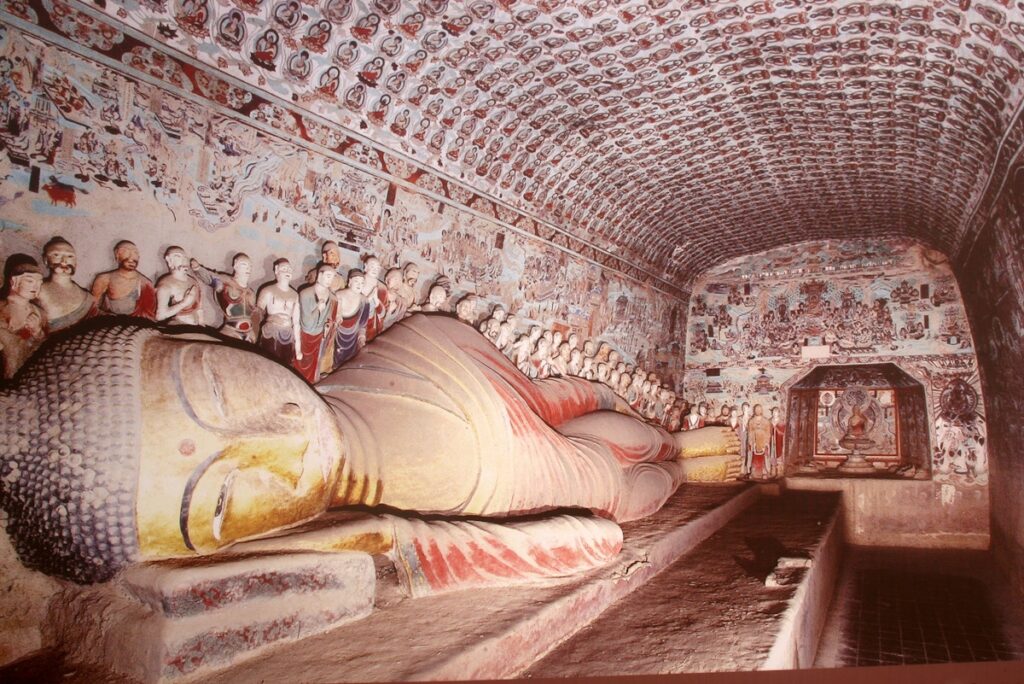There is still a dearth of domestic experts in the conservation of cultural sites in the face of climate risks, as well as specialists engaged in restoration work, said Li Chao. Researchers from Dunhuang Academy generally need to provide support for sites beyond Mogao too, and everyone is under great pressure from the workload, she added.
A good example is Gansu’s Jinta Temple Grottoes. In late July this year, a reporter from Caixin magazine visited the grottoes and discovered that the interior “monitoring system” was just a common household thermo-hygrometer – measuring temperature and humidity – which the staff hung below a camera to facilitate all-weather “readings”. These grottoes are located in an area with abundant rainfall and the cliff face is of red sandstone, which is not very water tolerant. They are therefore under much more threat than the Mogao caves and the monitoring equipment is not fit for purpose.
Dunhuang Academy has helped the Jinta Temple Grottoes design restoration plans and digital experiences to minimise tourist damage. However, when asked about the difficulty of bringing the Mogao Cave learnings to the Jinta Temple, Wang Weidong, deputy director of the Zhangye Cultural Relics Protection Institute, told Caixin that they lacked the funds for conservation, personnel, as well as tech and equipment support. “It comes down to human and financial resources,” Wang said.
Global cultural heritage
“World Heritage and Tourism in a Changing Climate”, a report jointly released in 2016 by UNESCO and the UN Environment Programme, pointed out that climate change has already become one of the most important factors threatening cultural sites globally.
The damage caused to world heritage conservation by climate change is slow but significant. In July, an editorial in Ecological China, a media platform managed by the Ministry of Natural Resources, stated:
“Cultural relics in different regions face different troubles. Beijing’s frequent sandstorms mean that, for the Forbidden City’s interior furnishings, wooden articles, murals, and so on, it’s necessary to draw up countermeasures against sand and desiccation; some ancient buildings in the south need to worry about the threat posed by termites, microorganisms, moisture, and mould. The darkening of the Leshan Giant Buddha [in Sichuan province] is because the rainy weather creates a hospitable environment for microorganisms to multiply on the surface of the statue.”
Li Guanghan, assistant director of the UNESCO World Heritage Institute of Training and Research in the Asia and Pacific Region (Beijing), told China Dialogue that not many projects in China are like the Mogao caves, having historical climate data and the ability to provide long-term protection against climate change. Most are about reactive conservation – repairing damage after a climate-related disaster, she added.
In August this year, China held the inaugural International Forum on the Protection of Cave Temples. It issued a “Declaration on Cave Temple Conservation in the Context of Climate Change”, and proposed to “explore preventative protection” and “focus more on the systematic protection of small- and medium-sized grottoes”.
Li Guanghan said that the unequal allocation of resources for cultural heritage protection was a “cruel reality”, and that heritage determined to be of “higher value” would always receive more resources. The social and cultural impacts of climate change on heritage sites were often overlooked, she added. For example, climate change may force traditional villagers to stop farming, change the way they do, or even leave their village permanently.
“On the one hand, climate change has a huge impact on tangible and intangible cultural heritage, and needs people’s attention,” she said. “On the other, protecting agricultural landscapes, traditional villages, and the traditional farming relationship between people and the land, actually reduces changes in the way land is used, and assists with climate adaptation.”
In her view, China’s efforts in cultural heritage conservation are gradually growing thanks to increased governmental attention and the country’s growing status in the field. Cultural heritage is a public good, she said. In China, as elsewhere in the world, government departments usually take the lead in conservation efforts, with close involvement from universities and research institutions. However, China still needs to establish a mechanism for civic involvement and growing public awareness, she added. This could, for example, be by mobilising residents of ancient villages to maintain the landscape of their own community, enabling multiple parties to work together to protect cultural heritage in the face of a changing climate.
This article was originally published on China Dialogue under a Creative Commons licence.



